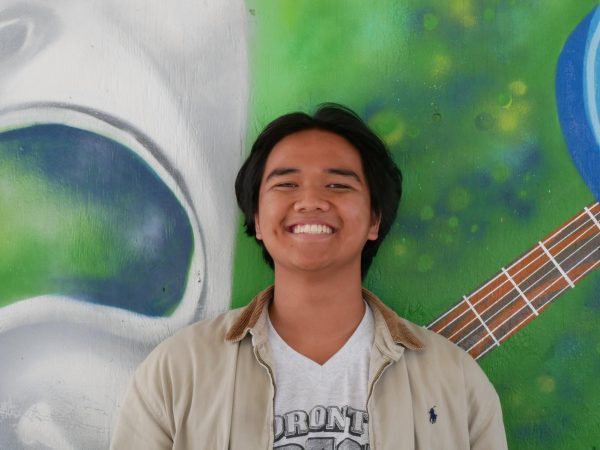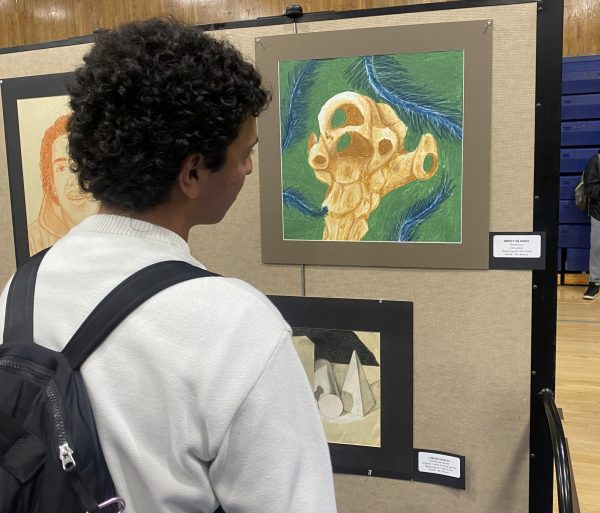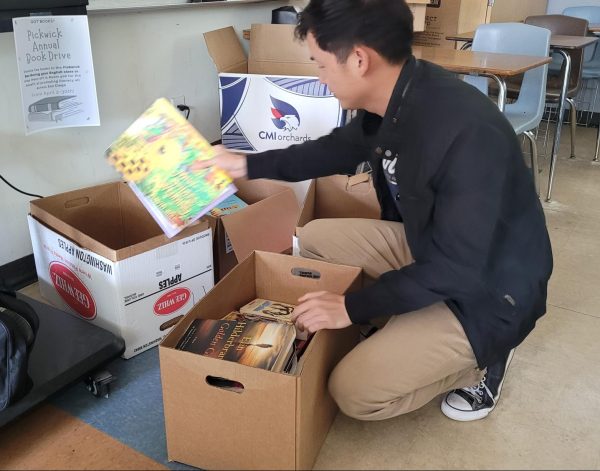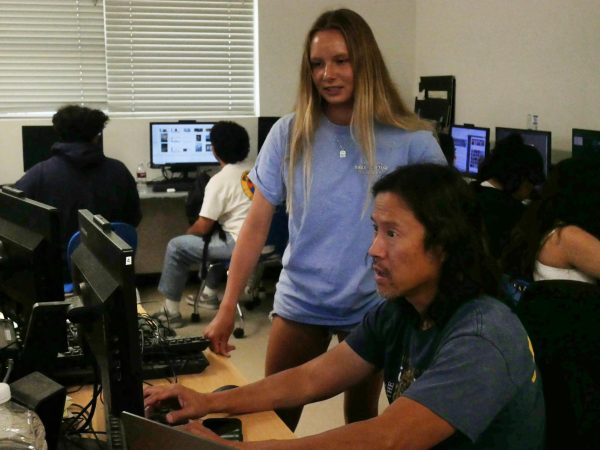“A beacon of hope and possibilities”
On Mar. 12, at the 95th Academy Awards (Oscars) the film Everything Everywhere All At Once received seven wins out of 11 nominations. Actress Michelle Yeoh and actor Ke Huy Quan are depicted here collecting their Oscars, respectively.
The 95th Academy Awards (Oscars) ceremony, which took place on Mar. 12, 2023, was utterly historic. Everything Everywhere All At Once, an American absurdist science fiction dramedy directed by Daneil Kwan and Daniel Scheinert–known collectively as the Daniels–swept the awards show with a whopping seven wins out of their eleven nominations.
The academy has had its fair share of controversial award choices throughout the years. However, not only did the general public lack any outrage over the multitude of awards given to Everything Everywhere All At Once, but it seemed as if most people celebrated the films dominance of the award show. The movie’s popularity amongst audiences is also supported by its box office numbers, specifically the $130,253,457 that it made worldwide.
The movie follows a Chinese immigrant mother named Evelyn—played by Malaysian actress Michelle Yeoh—who has to deal with running a failing laundromat. Alongside this, Evelyn is dealing with the disconnect between her and her daughter—played by American actress Stephanie Hsu—who’s mental health, sexuality and way of life confuse her. She’s also trying to uphold a failing marriage with her naive husband—played by American actor Ke Huy Quan— and having to live up to her ever-so disappointed father—played by American actor James Hong—traditionalist expectations. Amidst all this chaos, Evelyn is given the ability to multiverse-hop in order to defeat an alternate version of her daughter named Jobu Tapaki, whose goal is to destroy the multiverse.
A movie with a plot as convoluted and colorful as the one just described is far from the first thing to come to mind when you think of a best picture winner, but somehow Everything Everywhere All At Once pulled it off. As of the most recent award season, Everything Everywhere All At Once is the most awarded film in history from major awards bodies and critics organizations, with a staggering 264 wins in all according to issuu.com.
On top of being as critically acclaimed as it is, Everything Everywhere All At Once also holds massive importance in how it presents Asian people and experiences to such a vast audience. Both the writing and acting in the film highlight genuine Asian customs and culture, critiquing the many stereotypes that haunt Asian people as well as critiquing the toxic aspects of Asian heritage.
Yeoh was one of the three cast members of the film to go home with an Oscar for her incredible performance. Yeoh’s performance is astonishingly important to the conversation of representation in Hollywood: she’s the fourth woman of color and first Asian woman to win the Academy Award for Best Actress. Yeoh winning the award could potentially open new doors for diversity within the American film industry, which has historically struggled with telling stories that aren’t tailored to a white audience.
Even in today’s times, it’s still common for Asian characters to be replaced or played by white actors or characters, otherwise known as whitewashing. Take the example of Caucasian actress Scarlett Johansson playing Japanese character Mokoto Kusanagi in Ghost In The Shell (2017). Whitewashing is “often done to shoehorn in a star with the belief that actors of color would not be successful in the box office” according to “Hollywood Whitewashing and the Evolution of Film Diversity” written by Pascal Ezeabasili of The Edge. However, the $130,253,457 that Everything Everywhere All At Once pulled in worldwide effectively disproves the assumptions made by many white producers in Hollywood that film with Asian actors won’t make the same amount of profit as a film with white actors..
Yeoh has full awareness of the importance of her Oscar win. She boldly proclaims that her trophy is a “beacon of hope and possibilities” to Asian people in her acceptance speech, especially young Asians who aren’t used to seeing Oscars go into the hands of other Asians.
Within the action genre, it’s a common occurrence for Asian characters to be stealth “ninja” types, especially Asian women, who are usually characterized as physically weak, but able to defend themselves through oddly sexualized means of fighting. The thesis The Marginalization and Stereotyping of Asians in American Film done by Isabel Paner of the Dominican University of California calls this type of female Asian character the “dragon lady,” which is rooted in the stereotypes that Asian women are villainous or seductive.
Everything Everywhere All At Once makes sure to shy away from the “dragon lady” by making Evelyn everything but cold or sexual. Though confused in the beginning of the movie, Evelyn’s character becomes somebody that seeks to understand her opponents rather than seduce them. When she’s forced to show it, Evelyn’s wushu-inspired fighting style maintains all of the beauty and high quality choreography of old fashioned Kung Fu movies, but replaces the “feminine” hyper-perfection that “dragon lady” characters often embody with a gritty and chaotic aesthetic that goes against previous stereotypes.
A stereotype that the film doesn’t avoid, but instead gives depth to is the stereotype that Asian men are less masculine. Again referring to Paner’s thesis, Asian men are often “portrayed as ‘losers’ who have all the brains but no social skills or clueless immigrants fresh off the boat.” These are characters that constantly embarrass themselves as a result of their misunderstanding and idolization of American culture. Examples of such badly written Asian characters include Long Duk Dong from Sixteen Candles and Rajesh Koothrapalli from The Big Bang Theory.
The character Waymond, Evelyn’s husband, is characterized as a very submissive and naive people-pleaser who’s always trying to satisfy everyone around him. Though Waymond seems to resemble the unattractive foreigner that many Asian men are denoted as, his character is given depth when it’s revealed that his people-pleasing nature isn’t a sign of weakness, but rather his intelligent way of dealing with the world around him. Waymond finds joy in being kind to others, and though some may see his kind nature as vulnerable, it’s his indomitable kindness that saves the day.
On top of breaking down racist stereotypes, Waymond’s character also gives the audience a good example of healthy masculinity. Green Hill Recovery defines healthy masculinity as “the idea that men can be emotionally expressive, have female friends or mentors, and express their emotions without feeling emasculated.” Waymond exemplifies these features, his kindness in times of desperation, reliance on his wife to be head of the household, and his openness to express his emotions and weakness go against what many of the hypermasculine influencers of today seem to preach. By going against toxic-masculine ideals, the character of Waymond teaches positive lessons to young male audiences.
By going against toxic-masculine ideals, the character of Waymond teaches positive lessons to young male audiences.
— Isaiah Benitez
Quan’s acceptance speech at the Academy Awards is one that brings tears. His story started as a child facing hardships as he immigrated to the states, then he became a forgotten child actor after some short lived fame, and now he stands victorious, holding one of the most coveted accolades in cinema. As Quan put it, he’s living the truest version of “the American dream.”
Despite the importance of Waymond and Evelyn’s characters in destroying or giving depth to Asian stereotypes, both their daughter Joy, and the villain of the movie Jobu Tupaki highlight issues within the Asian community. Everything Everywhere All At Once uses Joy and Jobu to critique how many Asian parents hold excessively high expectations for their children, whilst those children have to deal with the pressure of adapting to a vastly different culture outside of the house. The cultural aspect that separates Asian parents and their children is especially apparent in the differing values that Evelyn and Joy possess.
The progressive American culture that Joy had been raised with clashed with the more conservative Chinese values that Evelyn had subconsciously forced upon her. According to “Disempowering Parenting and Mental Health among Asian American Youth: Immigration and Ethnicity,” a study performed by the National Library of Medicine, “child-perceived acculturation gaps in early adolescence predicted parent-child conflict in late adolescence, which in turn increased symptoms of depression.” In the case of Evelyn and Joy, the inability to comprehend the other’s values resulted in Evelyn having a deep-seeded sympathy for her daughter, and Joy feeling a depression in the wake of not being able to obtain what her mother wanted for her.
By portraying the negative effects of the all too common high expectations that Asian parents have for their children, the creators of Everything Everywhere All At Once take a strong stance against those expectations. The movie promotes the notion that toxic intergenerational customs can be overcome by being kind to the next generation.

I am a senior at Bonita Vista High (BVH) and a Sports Editor for the Crusader. I joined staff in the second semester of last year on a whim and became...



















